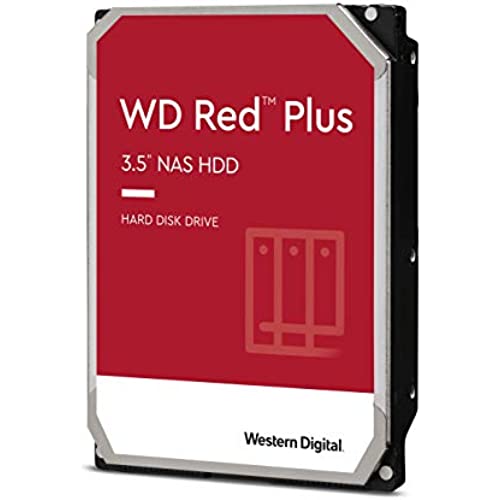
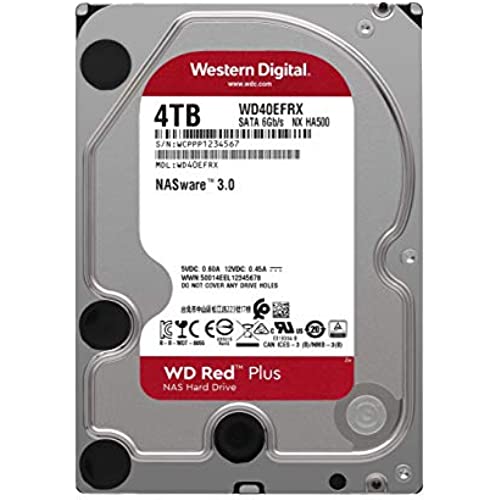
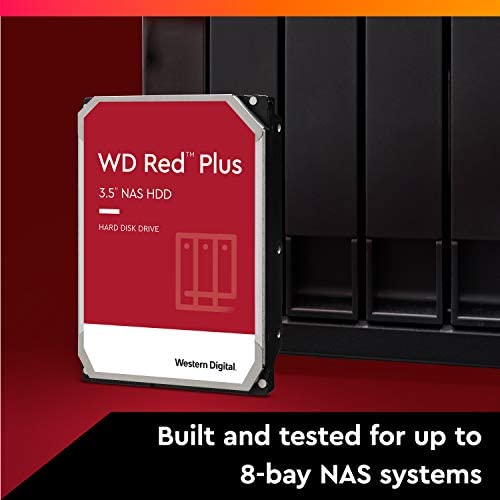
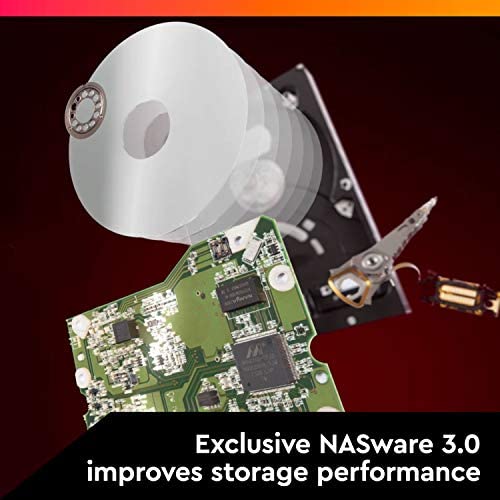

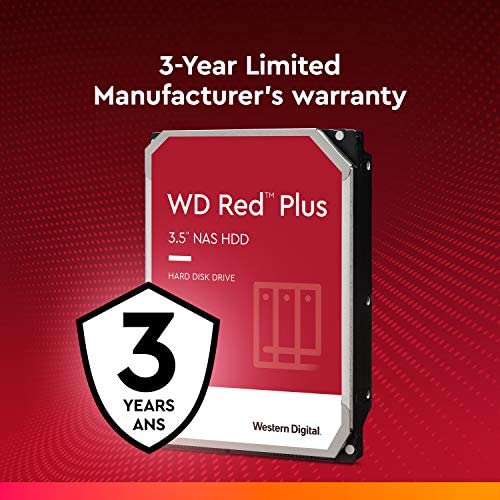
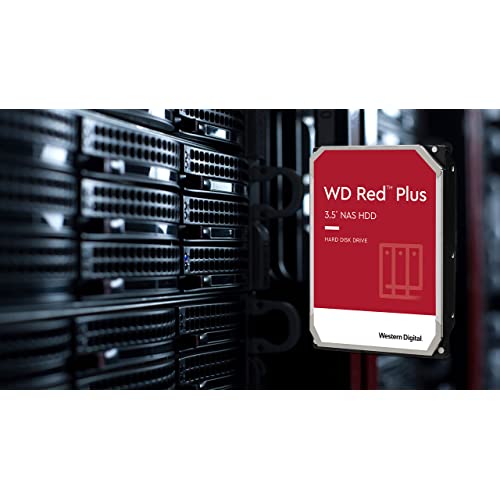







Western Digital 4TB WD Red Plus NAS Internal Hard Drive HDD - 5400 RPM, SATA 6 Gb/s, CMR, 64 MB Cache, 3.5 - WD40EFRX
-

T. Mccleary
> 3 dayIf youre looking at this review, youre probably in the market for some honkin big drives to stuff into a server or a NAS box. These Western Digital Red series drives are probably a total waste of money if youre planning to put them into a regular PC. If youre not doing a raid array of some kind, then save your money and buy the green or black series drives instead. If youre looking to set up a raid array of some sort, these are a bargain. They arent the fastest drives, but they are rated to run 24x7 serving up data! Their 3 year warranty is above the current industry standard for consumer hard drives. For my home-made FreeNAS (google it!) NAS/Server, I bought 5 WD Red drives from Adorama (purchased through Amazon) and 1 drive directly from Amazon. The one drive from Amazon came very well packaged, double boxed in what looks like a WD cardboard box with a shock absorbing cradle. Very well packaged for shipment. Honestly, Amazon has been stellar for packaging boxes for shipment. The 5 hard drives from Adorama came in a big box which clunked when it was tilted. Opening the box revealed some big plastic pillow air strips, and 5 loose smaller boxes. Inside each of the smaller boxes was a few pillows and a factory bagged hard drive. There were not enough pillows in each box to securely cushion the hard drives against rattling around, so theres a high likelihood of damage in shipment. BAD SHIPPERS! NO DONUT! Anyway, getting on to the performance of the drives... Im running 6 drives in a ZFS RaidZ2 array. They are all controlled using an IBM M1015 PCIE 8x SATA 3 controller which has been flashed to be an HBA providing JBOD to the ZFS OS. Thats a lotta acronyms! The speed of the array is quite fast... more than fast enough to saturate a gigabit network. I currently have about 5TB of data stored on the 10TB array. On to the bad stuff... One of the drives (I havent checked the serial number to see which shipper it came from) is starting to give signs of premature failure after about 70 hours of operation. During a scrub of the data pool, drive DA5 is experiencing unreadable sectors. Luckily ZFS is able to calculate the correct values for the corrupted data, and is busily recreating the data onto another part of the drive. ZFS rocks for data reliability! If the drive does turn out to be bad, I have a WD Green 3TB drive that I can put into the array as a hot swap temporarily until the failed drive can be replaced. *UPDATE* The ZFS scrub just finished, and it repaired 1.53MB of data, with no data loss. Did I mention that ZFS rocks? Warning/Advice about Data Storage: Note 1: If youre going to be using these drives, or any data storage device for that matter, make sure that you take into account that these are highly fragile and delicate devices which can be easily damaged in shipment, or just plain up and fail when you least expect it. You really need to use some sort of redundant array of drives so that if one drive fails, your data doesnt vanish. In my case, the final configuration is going to be 6 drives in a RaidZ2 (dual parity striping), which means that my data stays intact and accessible even if 2 drives fail simultaneously. Also, there is going to be a 3TB Green drive as a hot spare that can take over for any failed drive in the array. With the hot-spare, my data can survive the loss of 3 drives without losing data (as long as the failures dont happen all at the same time). Note 2: Always, always, always have a backup. In my case, I have two external 3TB USB3.0 drives which will be used only for backup purposes. Every so often, Ill backup the critical data onto the drives and stash them in my locker at work. If you dont have TrueCrypt, google it and see why your backup removable drives should be using it. If someone steals the drives, they only get the drives and not my data. Im giving 5 stars for the drives that work... 1 star for the failing drive... averages to about 4 stars score! Ill update this review once I have details on how the drives do in a week or so. Currently it aint looking too good for drive DA5!
-

Adrenolin
07-06-2025Purchased 26 of the 4TB drives from Mar - May of 2015 for a small home build using FreeNAS and a 24 bay Supermicro chassis. All drives were purchased through Prime and Amazon.com Services, Inc, no 3rd party sellers. I registered every drive in May or 2015. These drives have been running 24/7 with over 35000 hours running with temps ranging between 23-26*C in a below-grade basement server room. During this time Ive had just 2 drives begin to fail with READ errors, 1 in 2017 and another in 2018. No data was lost and only a few warning errors popped up before removing. I filled out the online replacement forms, printed them off, packed up the drives after swapping out with a spare and shipped them off. WD send brand new replacement (not reconditioned) drives back to be both times. Iirc I had the replacements within 2 weeks or sending them in. Drives are now out of warranty of course but Really.. what more can one wish or hope for! Still have 3 brand new drives if any issues arise. Im currently in the process of ordering the newer 8TB WD Red drives now to begin replacing these aging (but still working 100%) 4TB drives. Couple of months I should have 26 of the 8TB drives to start replacing these ones. Looking forward to the increased drive space but also knowing I have the most rock solid drives one could hope for! Worked in the IT field before retiring and have dealt with both PC and Server hardware from end users in their home, to local and national service providers, to full on massive data centers. Have used pretty much every manufactures drive available over the years. Ive always been extremely happy with Western Digital products and service.
-

amateur biker
Greater than one weekI purchased the WD My Cloud EX4 16 TB in July 2015. Late October 2020 one of the drives due to an unknown fault/error. The EX4 has a 3 year warranty, which means I got an extra 2 years out of the MTBF. WD now has the https://smile.amazon.com/Western-Digital-Network-Attached-Storage/dp/B0842S8HTF/?_encoding=UTF8&pd_rd_w=t54XZ&pf_rd_p=58f68c27-9bf4-466f-b1c8-101a062bcc82&pf_rd_r=QHREDXZYPYN5PP85XF1C&pd_rd_r=06a3bbe6-2d6a-4221-9cd3-e51b1993cc65&pd_rd_wg=7hWCr&ref_=pd_gw_wish .56 TB capacity(means 42 usable in RAID 5). The EX4 is a decent buy if you are looking for storage. Video (dvd quality) streams smoothly using both PLEX (running on a pi 3) and EMBY (running on a Dell laptop). Just make sure you check the front panel periodically as not all faults throw an error on the dashboard. Keep the firmware up to date with auto update.... check however as a fault will prevent auto update to protect faulty RAID structure for recovery.
-

Cory in AZ
> 3 dayI purchased several of these hard drives to populate a NAS. I have been using Western Digital drives for decades and they have always been reliable and affordable. For my project, I under-estimated my drive requirements because I completely forgot about the dishonest business practice of drive manufactures counting 1000KB = 1MB. In real life, 1024KB = 1MB. The end result is that the consumer loses space and the manufacturer gets to advertise a larger capacity than what the hard drive can actually deliver. In a 4-bay NAS using 8TB drives, basic math says 4 drives x 8TB = 32TB of storage. In reality, you only get 29TB (4x7.25), which is a significant loss of 3TB over what the manufacturer advertises! Grrr!
-

somerandomguy
> 3 dayI have purchased 6 of these 4 TB WD Red drives for a Synology DS2413+ NAS. Installed the drives, partition and deep scan took about 12 hours for a single drive setup and about 20 hours for the same with a RAID 1. I dont require anything else yet as I have offline backups and not yet enough storage to mirror all of the drives online, I dont want any smaller drives on the NAS. I plan on setting up multiple RAID 1s as I add drives to this system. They are easy to build and rebuild if I have problems. All six drives are in a basement area at 68f and the drive temps are 72f-73f. The were 83f when scanning and formatting. The packaging was superb, each drive is in its own brown cardboard box with plastic ends to keep the drive from shifting and then was packed in a larger box. No errors or problems with these drives so far. I need six more before I can get all of my movies and music online, will take awhile to image all of my retail DVDs and CDs. The NAS and the memory for it were also packed well and are running well. Love Amazon for their free shipping as a prime member, this almost paid for the years worth. Update 12-Dec-13 So far the drives are running fairly cool and are very quiet, I have added 2 more of the 4TB models to my Synology DS2413 NAS. This did increase the temps slightly, they now hover around 83f when idle. Room temp is about 70f. The NAS has passive cooling on the board (though it does have an exhaust fan) so more drives adds more internal heat. They are pretty fast when transfering data (too lazy to run a speed test) over the network but it is more than fast enough to run multiple movie streams.
-

MommaFrog
> 3 dayProduct met the sellers description
-

MeInDallas
> 3 dayIm an HTPC enthusiast, and Im using this 10TB red drive in my Windows HTPC. Im running a 60GB SSD that holds my Windows 10 Pro OS, and then I have several other much larger internal drives that I store my audio/video files on. I would not recommend installing your operating system on a hard drive this large. I can only imagine the problems youd run into. I have been running these red drives as extra storage for awhile now, and they work extremely well for the intended purpose. Ive been replacing my smaller green drives as they have aged, and its sad that WD doesnt make the green drives in these larger sizes. Ive only found the blue drives in sizes up to 6TB, so these larger red drives really fit the bill. They are the only 5200rpm WD drives I can find this large. If I run out of space in the main hard drive bay, I always install them in a 5.25 inch bay adapter, with at least a 80cm cooling fan. The main drive bay has a bigger fan of its own. Make sure you have a fan blowing on these large drives. Without proper cooling they can reach temps of 50C+ really quick, and that can mean a loss of your precious files. Ive been collecting stuff for 25+ years and I cant risk a loss. So, I always do a full format on my new drives from the start. Its a great way to test a new drive before you start moving those files over to the new drive. A full format on a 10TB hard drive will take around 12.5 hours, so just let it run overnight. Your fully formatted size will be 9314GB under the Windows OS. If you dont understand that then search the internet, its everywhere as to why. This drive was sold as a Plus drive, but I didnt see it printed anywhere on the drive as you can see. It doesnt matter to me though, because I will not being using it in a NAS system. I wasnt real happy about the manufactured date because it was almost a year ago. Wouldve preferred a drive with a more recent date. Other than those 2 things, I havent run into any issues with these red drives. They function really well for extra storage in my HTPC, and Im going to buy more as the size increase. I sure do wish WD would make green or blue drives in these sizes, not sure why they dont.
-

Roboknight
> 3 dayI would give these things a 1 star review just to get people to read this, but not this time. Ive bought these WD Red drives before. I consider WD substandard equipment, *HOWEVER* my theory is, if your backup system cant host substandard equipment, then you need another backup system. Ive been using OpenSolaris and these WD Reds for over a year now, and I can see that already Im getting some errors with two of the original drives. They both show about 7k+ errors when you look at the smart report (something you should be doing if you arent. Do yourself a favor and build smartctl if you dont already have it.). So I expect Ill be replacing those drives first. At any rate, I dont think I got any DOAs from Amazon so far. Im doing a surface analysis on the new ones to see what kind of shape they are in. But, these drives are priced pretty well at about $0.39/MB. You can probably do a little better, but these are pretty good drives. One other thing to consider when looking at drives: there are drives with higher capacities (4TB, 5TB, 6TB as of this review), but before you consider those too hard, realize that you are trusting your data to statistics no matter WHICH drive you buy. The ECCs that these drives run are large enough that you are guaranteed to get errors (yes, guaranteed), just by the sheer volume of bits they contain. There is no avoiding it. However, at 3TB, that is about the sensible limit where your ECC doesnt outstrip your data. On the larger drives, the same ECC is used (so its size doesnt become ridiculously large), but that means you are taking much more of a risk losing data. This website explains it better than I can: http://blog.fosketts.net/2014/12/19/big-disk-drives-require-data-integrity-checking/ , but it is one of the reasons I choose the 3TB drives vs just buying bigger drives. I might do so in the future, possibly, since ZFS is pretty good at protecting against bit rot, but for now, these drives are about the right drive for long term data storage.
-

gadgetfreak
> 3 dayThis purchase was made as a replacement for the same drive that had recently failed after about 2 years of backup-only use. I do not test the drive for speed, as thats not its purpose (I have WD Blacks and SSDs for that). Im purchasing strictly for reliability. So why the 3 stars? Pros: - The drive offers good capacity at reasonable prices - Designed for use in NAS or other similar applications - Runs seemingly cool Cons: - I had one fail not too long into its life (e.g., ~2 years) - That warranty is potentially useless if, like me, you are nervous about sending a non-wiped drive back to WD for replacement. I will elaborate on the concern... I contacted WD about the failed drive, and they readily were willing to replace it. That being said, since the drive has failed (clicking sounds, etc.), it is impossible for me to get it to mount, and therefore it is impossible for me to erase the drive. I suspect that with very little effort, someone with a little hardware expertise -- e.g., lots of people at WD -- could get the drive working again and have ready access to all my info. Give this 4TB drive is the clone of my entire digital life, I just wasnt comfortable sending the drive back to the company. And of course, if I were to crack the thing open, Id void the warranty. Ive read lots of views online about WDs policies and procedures on protecting info, but when it came down to risking all my info, I wasnt able to pull the trigger on the exchange. For other utilitarian data, Id have no such qualms. Obviously, this is a personal choice and you may be more trusting than me. In which case, paying a little extra for a 5 year warranty makes sense. So consider what you would do in a similar situation as mine. If you have come to view spinning-platter drives as disposable items, consider saving a bit of money and buying something with a shorter warranty -- particularly in an application like mine (a clone) where its easy to swap a new drive in. Undoubtedly you will pay less per TB in a year or two. Or youll go SSD if the pricing is finally right.
-

Jonathan Birge
> 3 dayThese have been rock solid for several months in a Synology NAS. They are running nearly continuously backing up multiple computers on my LAN. While seeks are occasionally loud, they are about as quiet as a whisper while spun up, and create no noticeably vibration. Even if you touch the mount with your hand. They really DO engineer this differently for use in a multi-disk NAS. Its only been a month (Ill update as time goes on) but so far there have been no misreads or bad sectors. For what its worth, I have had absolutely none of the issues with the high cycle counts that others have seen. I didnt have to upgrade the firmware, either. So, perhaps the issue is fixed. Even with my NAS fan set to quiet these have been running fairly cool. The highest temp Ive seen is 90 degrees F, and thats during summer in a room that is kept at about 86 degrees. So, pretty cool all things considered! The only potential downside to these is that in order to get them so quiet and efficient, the spindle speed is rather low: 5400 RPM. Like all drives, the 3 GB/s max transfer speed is meaningless. Youll never get that except for a cache hit on a small amount of data, and that will almost never happen because your computer will probably have cached it, too. In terms of sustained transfer, Im running RAID 5 with four disks and Ive never seen reads faster than about 100 MB/s. I suspect 7200 RPM drives would be able to support much faster RAID reads. Despite the fact that these arent designed to be the quickest drives out there, Im extremely happy with them so far and they have been a great value. When I run out of space I plan to upgrade the NAS to the 6 TB version of these.
